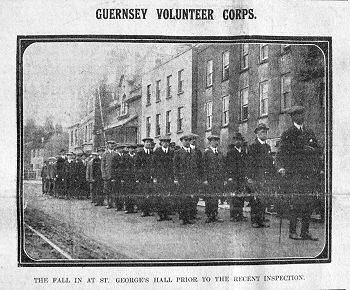|
|
The Channel Islands and the Great War
|
|
The Guernsey
Volunteer Corps
Page 1
|
|
The first reference to a Guernsey Volunteer Force appears
to have been in August 1914, when the Weekly Press (1)
published an article signed by H. St Leger Wood, DAA and
QMG, stating that HE the Lieutenant Governor of Guernsey
proposed forming a contingent of 'B' Section, Royal Guernsey
Militia, in case their services should be required. Volunteers
would be free to live at home and carry on their normal
work, and would only be called on in case of emergency.
By October 3rd 1914, the same newspaper was reporting
on an inaugural meeting at the States Intermediate Schoolroom,
attended by some 60 people, to discuss the advisability
of forming a local Civilian Volunteer Corps. The enrolment
form stated that "the object is to render all
possible assistance to the military authorities during
the present war by the preliminary training of men in
military duties."
This Corps was to be composed of British
subjects 'of good character', resident in Guernsey
who were over military age (35 at this time) but under
the physical standard required for the Army. (2)
|
|
Militia Reservists of Section B, mentioned
above, were to be incorporated into the Volunteers. All
expenses were to be undertaken by members of the Corps,
the organisation of which was to be as nearly as possible
on military lines. In answer to a question from the floor,
the audience was told that a serviceable, plain uniform
could be purchased for 30s to 40s, though khaki would not
be available because of the demand from active Service units.
St George's Hall was to be used as Headquarters, with preliminary
drills to be held between 8 and 9 pm on weekday evenings.
41 men enrolled at that first meeting, and Davis reports
that '…. drilled by Militia instructors the volunteers
made rapid progress in the intricacies of section and platoon
drill, their enthusiasm maintained at white heat despite
the fact that they were "armed" with dummy rifles.'
The Weekly Press of November 7 1914 states that Colonel
Mosse had consented to serve as Commanding Officer, and
that, as there would be some expense, a subscription of
6d per week had been set. Davis reports that 'Uniforms
were bought, a miniature rifle range established, and a
section was selected for instruction in the use of a machine
gun (Maxim) attending a course of lectures at Castle Cornet.' |
 |
The Corps must have proved popular, as by
late 1914 the Weekly Press (3) was reporting that 'Until
further notice Platoons 1 and 2 will drill each Monday at
St George's Hall at 8, and Platoons 3 and 4 will drill on
Tuesdays at the same place at the same hour. Casuals and
special classes will be provided for at St George's Hall
at 8pm on Fridays'. This group included anyone who had served
in the Militia. A platoon typically consisted of 30 to 40
men. A band too was formed, and on March 25th 1915, (4)
the Corps made its first public appearance, taking part
in a route march and parade at Cambridge Park. Later they
undertook Field operations at Lancresse and other parts
of the island. A picture published in the Weekly Press of
this time (5) shows them in civilian clothing standing to
outside St George's Hall prior to an inspection. In July
1915, (6) the Lieutenant Governor, Sir Reginald Hart, accepted
the position of Honorary Commandant of the Corps. The Weekly
Press of 28th August 1915 lists 'Promotions and Appointments
made to the Guernsey Volunteer Corps'. These include
20 NCOs, and over 50 new recruits posted to the various
Sections of the Corps. |
| |
|
| |
Page 2  |
|
|